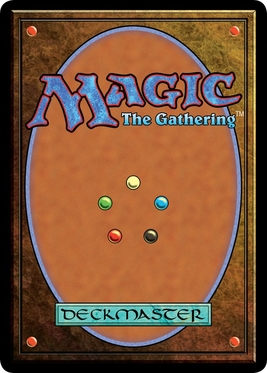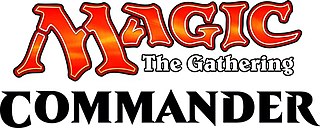
Magic: The Gathering is a tabletop and digital collectible card game created by Richard Garfield. Released in 1993 by Wizards of the Coast, Magic was the first trading card game and had approximately fifty million players as of February 2023. Over twenty billion Magic cards were produced in the period from 2008 to 2016, during which time it grew in popularity. As of the 2022 fiscal year, Magic generates over $1 billion in revenue annually.
Unhinged is a humor and parody themed expansion set to the collectible card game Magic: The Gathering. Unhinged was released on November 19, 2004. Its tone is less serious than traditional Magic expansions. It is a follow-on to Unglued, an earlier humor themed expansion set. It was followed in turn by Unstable
Magic: The Gathering Limited Edition is the first Magic: The Gathering card set. It premiered in a limited release at Origins Game Fair in 1993, with a general release that August. The initial print run of 2.6 million cards sold out quickly, and a new printing run was released in October 1993. These two runs are known as Limited Edition Alpha and Limited Edition Beta, or just Alpha and Beta for short. Although Alpha and Beta are referred to as different sets by some, officially they are the same set; Wizards of the Coast had expected that people wouldn't necessarily be able to tell the two press runs apart. Beta fixed a number of misprints and errors on cards. The printer accidentally used different corner rounding dies for the second run, resulting in Alpha cards being noticeably distinct in shape and appearance from Beta cards and all subsequent cards. The Beta printing also included a revised rulebook with a number of clarifications, although creator Richard Garfield's short fiction "Worzel's Tale" was removed to make room. The print run of Beta is given as 7.3 million or 7.8 million depending on the source. Despite the set's print run being about three times as big as Alpha's, Beta sold out as quickly as its predecessor.
The collectible card game Magic: The Gathering published seven expansion sets from 1993 to 1995, and one compilation set. These sets contained new cards that "expanded" on the base sets of Magic with their own mechanical theme and setting; these new cards could be played on their own, or mixed in with decks created from cards in the base sets. With Magic's runaway success, many of the printings of these early sets were too small to satisfy the rapidly growing fanbase. Cards from them became rare, hard to find, and expensive. It was not until Fallen Empires and Homelands that Wizards of the Coast was able to print enough cards to meet demand; additionally, Wizards of the Coast published Chronicles, a reprint set that helped fix many of the scarcity issues with the earliest sets.
In Magic: The Gathering, Power Nine is a set of nine cards that were printed in the game's early core sets, consisting of Black Lotus, Ancestral Recall, Time Walk, Mox Pearl, Mox Sapphire, Mox Jet, Mox Ruby, Mox Emerald, and Timetwister. These nine cards were printed in the first sets of Magic: The Gathering, starting in 1993. They are considered among the most powerful cards in the game. Owing to their power, they were banned from being played in most competitive settings.
The collectible card game Magic: The Gathering published nine base sets from 1993–2007, also referred to as core sets. The base sets were considered descendants of the original Limited Edition, and shaped the default setting and feel of Magic. These sets consisted entirely of reprinted cards. These cards were generally simpler than cards in expansion sets, omitting multicolored cards, and used only the original abilities and keywords of Magic such as Flying and Trample. This simplicity led to many cards from these sets being considered "staples" of deck design. All cards were given a white border to mark them as reprints, with a few exceptions. From Fourth Edition in 1995 onward, a new base set would come out once per two years in the spring or early summer; for tournament play, that set would be legal for two years in the Standard format until the next core set replaced it.
Mirage was the first official block structure in Magic: The Gathering. This new block structure consisted of three expansion sets and would continue for nearly two decades, finally ending with Khans of Tarkir in 2014. The new block structure also set up the precedent that the first set in the block also became the name for the entire block. Mirage block consisted of three sets: Mirage, Visions and Weatherlight.
Christopher Rush was an American illustrator for Magic: The Gathering. In total, he illustrated over 100 cards for the series, including the most expensive card in the game, the Black Lotus. Most of his work for Wizards of the Coast was done on the earliest sets, where he also helped with various design and marketing issues, including the design of the symbols representing the 5 colors of mana.
Time Spiral is a Magic: The Gathering expert-level block consisting of the expansion sets Time Spiral, Planar Chaos, and Future Sight. It is set on the plane of Dominaria, the first time that that plane had been visited since 8th Edition.
The collectible card game Magic: The Gathering has released compilation sets, reprint sets, and box sets over its history. These are distinct from core sets and expansion sets, the most heavily marketed sources of new cards. With the exception of Chronicles, reprint sets generally do not affect tournament legality in supported formats; for example, cards reprinted in the Modern Masters reprint set, while legal for tournament play, did not necessarily cause the card to be included in the "Standard" environment.
Magic: The Gathering formats are various ways in which the Magic: The Gathering collectible card game can be played. Each format provides rules for deck construction and gameplay, with many confining the pool of permitted cards to those released in a specified group of Magic card sets. The Wizards Play Network, the governing body that oversees official Magic competitive play, categorizes its tournament formats into Constructed and Limited. Additionally, there are many casual formats with the Commander format being one of the most popular formats of the game.
The Lorwyn block is a Magic: The Gathering expert-level block consisting of two sets: Lorwyn and Morningtide. A third set, codenamed "Jelly", was originally planned as part of the Lorwyn block, but partway into the design of Lorwyn, it was split into a two-set block. Jelly was revealed as Shadowmoor, the first set of the new two-set block. The two blocks were linked together and rotated through the official tournament formats as a single, four-expansion unit. The primary theme of the Lorwyn block is tribalism.
Ravnica is a Magic: The Gathering block that consists of three expert-level expansion sets: Ravnica: City of Guilds, Guildpact, and Dissension. Following in the tradition of other Magic blocks, Ravnica takes place in a plane of the multiverse that was previously unexplored in the game's backstory. The world of Ravnica is an ecumenopolis, a vast city that covers the entire surface of its planet, and is home to a diverse assortment of sentient races. Much power in Ravnica is held by the ten "guilds", political factions that each represent a combination of two of Magic's five colors. The mythology of Ravnica is loosely derived from Slavic folklore, and the character names reflect this. This plane was revisited in the Return to Ravnica block, and the Guilds of Ravnica,Ravnica Allegiance, War of the Spark, and Murders at Karlov Manor sets.
The rules of Magic: The Gathering were originally developed by the game's creator, Richard Garfield, and accompanied the first version of the game in 1993. The rules of Magic have been changed frequently over the years by the manufacturer, Wizards of the Coast, mostly in minor ways. However, major rules overhauls have also been done a few times.

Commander is a series of supplemental Magic: the Gathering card game products. Its mechanics are derived from a fan-created format known as "Elder Dragon Highlander (EDH)".
The Artifacts Cycle is a tetralogy of Magic: The Gathering expansion sets centered on the exploits of Urza Planeswalker. It consists of the expansions Antiquities, Urza's Saga, Urza's Legacy and Urza's Destiny. The latter three sets are sometimes referred to as an "Urza block" for tournament purposes, since there have been formats and time periods in which cards from the later three sets were legal but cards from Antiquities were not. However, the books "The Brothers' War", "Planeswalker", "Timestreams", and "Bloodlines" unambiguously confirm that, from a story and thematic point of view, "Artifacts cycle" is correct and it begins with the events depicted in Antiquities.
Seven Magic: The Gathering core sets have been released since 2009: Magic 2010, Magic 2011, Magic 2012, Magic 2013, Magic 2014, Magic 2015, and Magic Origins. Unlike 10th Edition and previous core sets, roughly half of each core set was entirely new cards. Beginning with Magic 2010, Wizards decided to introduce new cards into the Core Set so that they could be relevant for both new players as well as veterans. Starting with Magic 2011, core sets have included "returning mechanics", or non-evergreen keywords with cards printed in just one core set. All of these core sets were released in the summer of the year prior to the year in the title - for example, Magic 2010 was released in 2009.

Magic: The Gathering Arena or MTG Arena is a free-to-play digital collectible card game developed and published by Wizards of the Coast (WotC). The game is a digital adaption based on the Magic: The Gathering (MTG) card game, allowing players to gain cards through booster packs, in-game achievements or microtransaction purchases, and build their own decks to challenge other players. The game was released in a beta state in November 2017, and was fully released for Microsoft Windows users in September 2019, and a macOS version on June 25, 2020. Mobile device versions were released in March 2021.
Dungeons & Dragons: Adventures in the Forgotten Realms is an expansion set for Magic: The Gathering (Magic) released in July 2021. The world of the Forgotten Realms was created by game designer Ed Greenwood around 1967 as a paracosm for his childhood stories and premiered as a campaign setting for the Dungeons & Dragons (D&D) fantasy role-playing game in the Forgotten Realms Campaign Setting (1987). This expansion set is the third collaboration between Magic and D&D; both teams are part of Wizards of the Coast.



